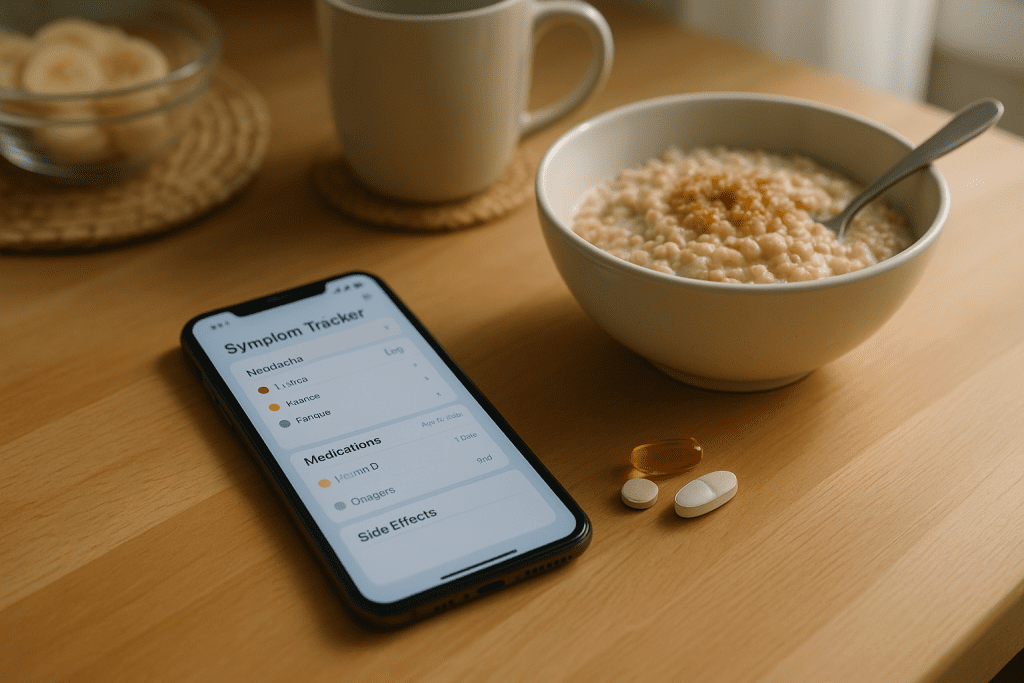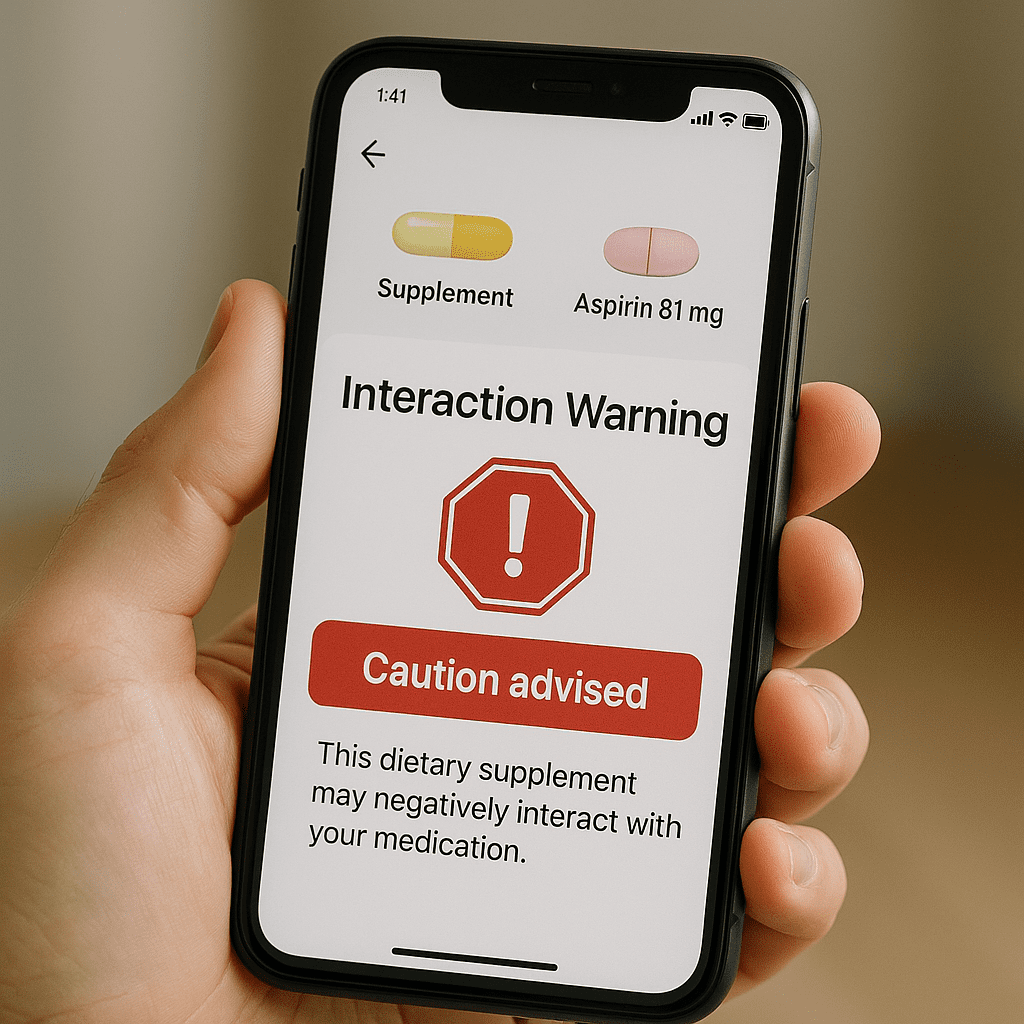A symptom tracking app supplements routine helps you catch side effects before they snowball into major problems. This guide explains how a side effect logger pairs real-time notes with drug-nutrient reaction checks, so you and your clinician can adjust treatments quickly and safely.
Summary / Quick Answer
| Need to know fast? | Answer |
|---|---|
| Why track symptoms? | Pinpoints patterns and early warnings of drug–nutrient reactions. |
| Key features | Interaction checker, custom symptom fields, reminders, secure export. |
| Top apps | Medisafe, CareClinic, Effecto, Bearable, MyRxProfile. |
| Data sharing | Most generate PDF or CSV reports you can email to your doctor. |
| Long-term gain | Builds a drug nutrient reaction journal for better dosing decisions. |
Why Track Symptoms and Side Effects?

Side effects rarely arrive with flashing lights. They creep in as dizziness after lunch or a mild rash three days after starting a new supplement. Without a daily log those signals blend into background noise, and valuable data is lost.
Tracking gives you three clinical advantages:
- Time stamping – noting the exact dose and moment a symptom appears strengthens causal links.
- Pattern spotting – interaction checkers flag known conflicts (for example, magnesium supplements lowering certain antibiotic absorption) while your log highlights subtler issues the database misses.
- Objective memory – digital logs beat human recall, which scientific reviews show fades within 48 hours.
| Common Questions | Quick Facts |
|---|---|
| “Isn’t a pill reminder enough?” | Reminders help adherence but do not record reactions or food triggers. |
| “What should I log?” | Dose, time, brand, meals, mood, sleep, new symptoms. |
| “Who sees the data?” | You control exports; reputable apps use HIPAA-grade encryption. |
A 2023 NIH update confirms that combining patient-generated data with electronic health records reduces medication errors by up to 30 percent. The takeaway: a side effect logger is the simplest DIY layer of safety you can add today.
Must-Have Features in a Side Effect Logger
Not every tracker is built for drug–nutrient precision. Use the checklist below before downloading:
| Feature | Why It Matters |
|---|---|
| Comprehensive interaction checker | Cross-references prescriptions, OTC products, and supplements. |
| Custom symptom fields | Lets you log niche reactions like tingling or food cravings. |
| Correlation engine | Graphs symptom spikes against doses, meals, or sleep debt. |
| Data export | Generates PDF/CSV for quick clinical review. |
| Privacy safeguards | End-to-end encryption and two-factor authentication. |
Look for optional extras such as wearable integration, voice entry, and caregiver alerts. Apps that sync with Apple Health or Google Fit pull in heart rate and sleep data, giving your doctor a 360-degree view.
Internal research at UsefulVitamins shows that users who export weekly summaries discuss medication changes 25 percent earlier than those relying on memory alone. For deeper details, see our Best app for tracking vitamin and drug interactions comparison.
Best Symptom Tracking Apps for Supplements & Drug Interactions
Below are the stand-out options, distilled from clinical reviews and user feedback:
| App | Stand-out Strength | Ideal For |
|---|---|---|
| Medisafe | 200,000+ verified interaction alerts; 90+ health metrics. | Complex polypharmacy schedules. |
| CareClinic | HIPAA-compliant reports; 2,000 symptom fields. | Chronic illness and care-team sharing. |
| MyRxProfile | Barcode scan populates meds instantly; catches “like ingredients.” | Quick safety checks in-store. |
| Effecto | AI correlations between lifestyle factors and symptoms. | Data nerds who love deep dives. |
| Bearable | Experiment mode tests new supplements systematically. | Users tweaking stacks or diets. |
Medisafe’s Medfriend feature pings a family member if you miss a dose, adding accountability. CareClinic integrates stool logs and nutrition diaries, useful when monitoring iron or calcium absorption. Effecto users on Reddit credit the app with uncovering delayed reactions to B-vitamin megadoses.
Remember: no single app fits every scenario. Trial a few for a week, export the logs, and see which layout your clinician finds most readable.
Data Export, Privacy, and Collaboration
Rich data is useless if it stays locked on your phone. Modern trackers make sharing painless:
| Export Type | Best For | How to Protect Privacy |
|---|---|---|
| PDF overview | Routine check-ups; quick glance charts. | Send via secure patient portal. |
| CSV raw data | Detailed analysis or research studies. | Remove personal identifiers first. |
| API sync | Continuous monitoring in telehealth platforms. | Use apps offering OAuth-based authentication. |
Before exporting, check the recipient’s preferred file type. Many clinics import CSV directly into electronic records. If you handle sensitive conditions, choose an app that stores data locally with optional cloud backup.
Health data breaches climbed 60 percent last year, so enable two-factor verification. Reputable developers outline encryption methods in their privacy policy; skim this section before signing up.
Collaboration tip: Bring a one-page “symptom highlights” print-out to appointments. Clinicians appreciate concise graphs over 30-day wall-of-text journals.
Long-Term Benefits: Building a Drug Nutrient Reaction Journal

Short-term logging spots acute problems; long-term journals unlock strategic gains:
- Seasonal insights – vitamin D doses might need winter boosts after reviewing year-long mood scores.
- Tolerance tracking – gradually rising caffeine or antihistamine requirements become obvious in graphs.
- Stack optimization – Experiment mode in Bearable or Effecto isolates which supplement pairs improve energy without GI distress.
A continuous drug nutrient reaction journal also acts as a living history. Should you switch doctors, exporting three years of data paints a clearer picture than intake questionnaires ever could.
| Timeline | What to Review | Action Step |
|---|---|---|
| 1 month | New side effects? | Adjust timing or dosage. |
| 3 months | Lab results vs symptom curves. | Update supplement stack. |
| 12 months | Seasonal symptom swings. | Plan preventive changes. |
The FDA advises reporting serious adverse events directly through MedWatch; some apps preload this form for you. When your journal and official reports align, you contribute to broader drug safety data.
Conclusion
Symptom tracking apps turn scattered side notes into actionable evidence. Choose a platform with a robust interaction checker, customizable logs, and secure exports. Over time, your symptom logger for drug-nutrient side effects evolves into a personalized playbook, guiding dose tweaks and preventing costly reactions. Ready for next steps? Compare interaction tools in our deep-dive post on the Best app for tracking vitamin and drug interactions or browse our nutrient timing guide.
